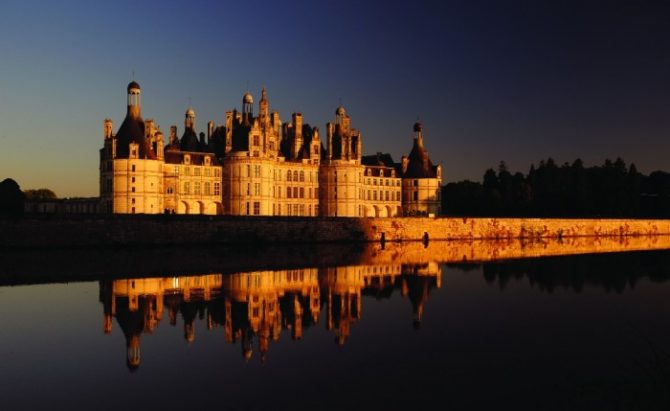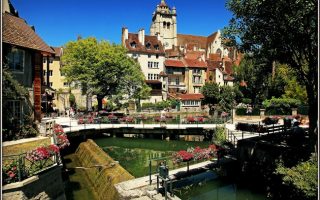Château de Chambord: Francis I’s Incredible Loire Valley Palace

Approached by a long, tree-lined road, the Château de Chambord is a breathtaking vision to behold, rising up like the Mont Saint-Michel, but out of an ocean of forest. With dozens of chimneys, cupolas, gables and towers reaching 56 metres into the air, and 440 rooms, 365 fireplaces and 84 staircases within, it’s the largest château in the Loire Valley, France’s ‘Valley of Kings’. During the Renaissance era, it was simply the greatest, most resplendent castle in Europe, an absolute architectural masterpiece which earned Francis I the nickname of Le Roi Batisseur – the builder king.
The fingerprints of Leonardo da Vinci, who was employed in the position of the king’s First Painter, Engineer and Architect until his death four months before construction began, appear to be everywhere. Upon visiting in 1539, Francis I’s greatest rival, the Holy Roman Emperor Charles V, declared that Chambord embodied “a summary of what human industry can achieve”.
Yet despite its glorious beginnings , in recent years has Chambord become the ‘Sleeping Beauty’ of French monuments? In 2013, visitors were no more numerous than in 1998 – 750,000. Over the same period at the Château de Versailles, visitors nearly tripled, from 2.68 million to 7.5 million, a trend seen among other major French sites. Chambord, it seems, has struggled to adapt to the realities of global tourism. Worse, through the centuries, Chambord’s meaning and purpose have become clouded in the public’s eyes. Often regarded as a lovely but oversized hunting lodge with too many empty rooms to merit a visit, today around twice as many tourists take a quick photo of Chambord from its parking area than those who actually step inside.
However, this year, as France celebrates the 500th anniversary of Francis I’s coronation, the Château de Chambord may finally be rising from its slumber.
For years, eight different public entities had a hand in Chambord’s management and this archaic system bogged down how the Château functioned until 2005, when it was finally regrouped into a single, streamlined commercial public establishment, a la Versailles or l’Opéra National de Paris. Over the next decade, numerous shake-ups took place across the 5440-hectare domain, which notably includes the Renaissance castle, Europe’s largest walled forest and the only entirely state-owned village commune in France.
A multi-million Euro restoration of the château was launched – from the famous double-helix staircase up to the fleur-de-lis-topped lanterne tower – and such fundamental posts as head curator, cultural director and communications director were created. Finally, this winter, Chambord adopted its first strategic plan since the state assumed its stewardship in 1930.
The project is ambitious and aims to achieve 100 per cent financial independence (versus the current 86 per cent) by 2020, notably by increasing the annual visitor figure to one million. The creation of a rich cultural calendar, improved visitor services and lodgings, resurrected historic gardens and the refurnishing of long empty rooms are all elements of the plan. The hope is to not only draw more visitors, but encourage them to linger, be it for an afternoon or a weekend, so that they can see Chambord in a radically new light.
Fresh Attractions
To boost Chambord’s allure, period furnishings loaned from the Mobilier National have begun reappearing in numerous hitherto empty rooms. Louis XV’s flamboyant 18th-century style is newly on display in rooms like the Maréchal de Saxe Appartement de Parade and the Appartement Conti, and the 17th century shines in Louis XIV’s refurnished Appartement de Parade. Chambord is even overseeing the recreation of chairs, beds and tapestries straight out of 16th century paintings and documents, for a complete refurnishing of King Francis I’s royal chambers by 2019.
The complete refurnishing of Chambord will take a while, so from this July visitors are to be offered the use of augmented reality ‘HistoPads’ – small iPads which allow them to view any room as it would have looked 500 years ago, when Francis I and his court were in residence.
Soon, though, no virtual-reality will be needed to behold Chambord’s forgotten gardens. Following on from last year’s replanting of English-style gardens between the château and village, based on a set of 1889 plans, Chambord’s Jardins à la Française are due to come back to life in 2016. The latter reconstruction follows the archival discoveries of 18th-century engravings depicting a cross-shaped garden on the château’s northwest side and architect Jules Hardouin-Mansart’s original plans, which were drawn up for King Louis XIV.
Re-Engineering Perception
Even as Chambord prepares for a boost in tourism, with a new visitor centre opening in spring 2016, and a tripling of lodging capacity underway – including luxury cottages a stone’s throw from the château and an €8 million renovation of the onsite Hôtel Saint Michel – Jean d’Haussonville, CEO of the National Domain of Chambord, has said that their greatest challenge remains: recasting Chambord’s identity in the eyes of the world.
Is Chambord an oversized hunting lodge, or a UNESCO world-heritage monument on par with the Great Pyramids in Egypt or Machu Picchu in Peru? Chambord’s new slogan, ‘Entrez dans le Monde du Genie’ (Step into the world of genius), seems to offer an answer. From Fontainebleau to Versailles, royal castles throughout French history underwent considerable modifications. Successive kings added wings while erasing their predecessors’ work. But not at Chambord.
“They say the work of genius is in the complete work, a work to which nothing could be added or taken away,” reflects d’Haussonville. “And we see that very well here – every French political regime had this intuition that you mustn’t touch Chambord… that they were dealing with a château completely unlike any other.”
King Francis I dedicated nearly three decades of his life to building Chambord and, by one estimate, the equivalent of half the state’s budget for construction during that time, all for a castle which was too remote and hard to heat, to ever really be a practical place to live. Indeed, Francis I would only sleep there a handful of weeks during his reign. But what if Chambord is less a castle than a work of astronomically expensive conceptual art?
As Henry James noted in the 20th century, at first sight, Chambord appears to be more than just “a single building… the towers, cupolas, the gables, the lanterns, the chimneys, look more like the spires of a city”.
During the Renaissance, theologians and humanist intellectuals like Erasmus and Thomas More were theorizing about the ideal society, drawing on everything from the Bible to the Kabbala to Plato, in order to imagine a city where everyone lives in equality. These ideas, well known to Kings and Popes, nourished some of the grandest architectural projects of the era. For historian François Parot, a Chambord guide, it’s no wonder both Francis I and the Pope, who was rebuilding Saint Peter’s Basilica in Rome while the Château was under construction, chose a Greek cross with equidistant arms as the form of their masterworks. “They were using the same archetype,” he says, “a sacred city, a particular ideal city”.
In the Old Testament it’s called ‘New Jerusalem’, in the Book of Revelations, ‘Heavenly Jerusalem’ or the ‘Celestial City’, where the 12 tribes of Israel, and all the world’s nations, will rejoin in harmony one day. The city is described as having four sides representing the four cardinal points (North, South, East, West), with gates open in every direction. When the Portuguese ambassador, Francisco de Moraes, described Chambord in 1541, he explained that the cross-shaped donjon or keep has four doors opening onto the four corners of the earth.
“Chambord is a reflection in stone of the ideas behind the Renaissance,” says d’Haussonville. “It’s an architectural metaphor for the eternal cycle [of life and the universe].”
At the heart of New Jerusalem is said to grow the Tree of Life, portrayed during the Renaissance as two entwined trunks. And what ascends through the heart of Chambord, to the very tip of the lanterne tower? A double-helix staircase, which is widely attributed to Leonardo Da Vinci.
“Chambord is to architecture what the Mona Lisa is to painting, it’s the major work of the Renaissance, and even if Leonardo Da Vinci might not be the author of Chambord he certainly inspired it,” says d’Haussonville. “It’s a work of genius, a concentration of intelligence which is unique in the world, but which takes time for one to begin to comprehend. However, once you start to reflect on Chambord, you find that it reads like a symphony.”
Interpreting the Symbolism
Of course, it helps to have a guide with the keys to interpreting Chambord’s secrets, such as François Parot or his colleague, Thibaud Fourrier, a Université de Tours historian. Parot and Fourrier have made the first comprehensive interpretation and inventory of Chambord’s myriad sculpted décors, which include salamanders, porcupines, Charlemagne’s imperial crown and angel wings, knotted ropes and fleur-de-lys…
“Some of these symbols have been here for 500 years, but we only first interpreted them a few years ago. But why would anyone be interested in them?” says Parot. “This was supposedly just a hunting lodge.” Far from it, Parot insists, “these décors allow us to understand Chambord, they are part of a sculptural programme”.
During a visit with Parot, Chambord comes to light as a symbol of power and legitimacy for Francis I, a king who wished to be seen as the rightful heir of the Clovis, France’s first Christian King. Legend said that an angel descended from heaven to anoint Clovis with a fleur-de-lis, his authority thus coming directly from God.
Seen this way, Chambord is Francis I’s majestic message to the world, but it’s also a vehicle for his most intimate conversations. The lanterne tower is covered with numerous mysterious carvings drawn from Christian and Jewish symbolism (figure eights, triple crosses) which are hidden from the view to those walking the terrace roof below. Other symbols inside, such as the great ‘F’s on the lanterne ceiling, have simply been carved backwards, as if they were intended to be read from above. As d’Haussonville puts it, “in these elements of Chambord’s architecture… the king is speaking to God.”
But can this ethereal dimension of Chambord really be made palpable for a tourist? D’Haussonville believes so. It’s what all these new gardens and rooms, walkways and holiday cottages are intended for – “creating spaces so that people have time to live, to experience Chambord inside and out, and to feel something here.”
For his part, d’Haussonville says, “There is a spiritual dimension here at Chambord. You feel it in the castle… the way all the towers are oriented in different directions, each turning by degree, you get this sensation of ascension. It’s a castle that dances, it’s spiralling toward the heavens.”
For more information, visit www.chambord.org
The Cultural Calendar: What’s on at Chambord during 2015…
For theatre lovers, what could be more magical than attending a play by Molière in the place it was first performed, in front of Louis XIV, some 345 years ago? This spring, the great Denis Podalydès of the Comédie Française will direct performances of Le Bourgeois Gentilhomme at Chambord (May 22-23). That event is just one example of how the château’s keepers are bringing the arts back to Chambord.
Other highlights include an exhibition of French artist Guillaume Bruère’s paintings inspired by Francis I (Apr 12-Aug 30), a show of photos of the Chambord forest by Korean lensman Bae Bien-U (Sept 27, 2015-Mar 20, 2016) and the Festival de Chambord (July 3-18), which offers 15 days of music from the Renaissance to the contemporary. There’s even a riotous equestrian show inspired by Francis I’s victory at the Battle of Marignano and Chambord’s history (May 1-Sept 27).
Walk through the Centuries with ‘HISTOPAD’
The château’s new augmented reality visitor technology explained…
Chambord’s extraordinary scale seems to guarantee the château could never be completely refurnished. Nonetheless, starting this July it will be possible to see Chambord as it would have looked centuries ago when the king and his court stayed at the château, thanks to the new, augmented reality ‘HistoPad’.
Walk into any room of the château, and these small iPads, which were created by the French start-up company Normandy Productions, become windows into the past. When a HistoPad is held up inside a room, a reconstruction of the historic décors — tapestries, furniture, etc —appears instantly, with pop up text and multiple interactive details. The HistoPad may well be a game changer for Chambord. In 2013, an earlier version of the technology was introduced at the Château de Falaise, William the Conqueror’s Castle in Normandy, and one year later the number of visitors had doubled.
From France Today magazine
Share to: Facebook Twitter LinkedIn Email
Leave a reply
Your email address will not be published. Required fields are marked *




REPLY
REPLY